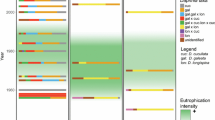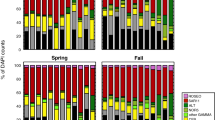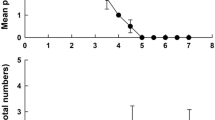Abstract
Lakes are well known for having a pattern of seasonal succession of phytoplankton and zooplankton. The succession of different taxa of phytoplankton results in a succession of zooplankton taxa, and within the genus Daphnia, into a succession of different genotypes (clones). One cause for this succession of Daphnia clones might be the production of digestive protease inhibitors by cyanobacteria, which usually bloom in summer. Here we report seasonal changes in the frequency and the abundance of Daphnia magna haplotypes in a eutrophic lake, which developed a chymotrypsin-inhibitor-producing cyanobacterial bloom in May. These seasonal changes were not related to changes of biotic and abiotic lake parameters. However, a very high content of chymotrypsin inhibitors was observed in May (but not in other months). This was assumed to have exerted a strong punctual selection pressure on the Daphnia population and on the direct targets of the protease inhibitors, i.e. the digestive chymotrypsins of Daphnia. Actually, D. magna from before and during the cyanobacterial bloom showed a different protease pattern on activity stained SDS-PAGE in comparison to clones from the month after the bloom. However, no difference in tolerance, measured as IC50 values, to inhibition by natural lake seston from May was found between the clones from before and after the bloom. Thus, the hypothesis that a seasonal adaptation of D. magna subpopulations from either April/May or June might have occurred could not be proven. This suggests that the Daphnia population investigated here is locally adapted to cyanobacterial protease inhibitors.







Similar content being viewed by others
References
Agrawal MK, Bagchi D, Bagchi SN (2001) Acute inhibition of protease and suppression of growth in zooplankter, Moina macrocopa, by Microcystis blooms collected in Central India. Hydrobiologia 464:37–44
Agrawal MK, Zitt A, Bagchi D, Weckesser J, Bagchi SN, Von Elert E (2005) Characterization of proteases in guts of Daphnia magna and their inhibition by Microcystis aeruginosa PCC 7806. Environ Toxicol 20:314–322
Blom JF, Baumann H, Codd GA, Jüttner F (2006) Sensitivity and adaptation of aquatic organisms to oscillapeptin J and [D-Asp3,(E)-Dhb7]microcystin-RR. Archiv fuer Hydrobiologie 167:547–559
Brzezinski T, Dawidowicz P, Von Elert E (2010) The role of food quality in clonal succession in Daphnia: an experimental test. Oecologia 164:379–388
Burns CW (1968) The relationship of body size of filter-feeding Cladocera and the maximum size of particles ingested. Limnol Oceanogr 13:675–678
Carmichael WW (1992) Cyanobacteria secondary metabolites: the cyanotoxins. J Appl Bacteriol 72:445–459
Carmichael WW (1994) The toxins of cyanobacteria. Sci Am 270:64–72
Carvalho GR, Crisp DJ (1987) The clonal ecology of Daphnia magna (Crustacea: Cladocera) I. Temporal changes in the clonal structure of a natural population. J Anim Ecol 56:453–468
Colbourne JK, Robison B, Bogart K, Lynch M (2004) Five hundred and twenty-eight microsatellite markers for ecological genomic investigations using Daphnia. Mol Ecol Notes 4:802
de Bernardi R, Giussani G (1990) Are blue-green algae a suitable food for zooplankton? An overview. Hydrobiologia 200(201):29–41
Degans H, Zöllner E, Van der Gucht K, De Meester L, Jürgens K (2002) Rapid Daphnia-mediated changes in microbial community structure: an experimental study. FEMS Microbiol Ecol 42:137–149
DeMott WR (1983) Seasonal succession in a natural Daphnia assemblage. Ecol Monogr 53:321–340
DeMott WR, Gulati RD, Van Donk E (2001) Daphnia food limitation in three hypereutrophic Dutch lakes: evidence for exclusion of large-bodied species by interfering filaments of cyanobacteria. Limnol Oceanogr 46:2054–2060
Fujii K, Harada K-I, Suzuki M, Kondo F, lkai Y, Oka H, Sivonen K (1995) Novel cyclic peptides together with microcystins produced by toxic cyanobacteria, Anabaena sp. In: 37th symposium on the chemistry of natural products (Tokushima), symposium papers, 445–450
Gademann K, Portmann C (2008) Secondary metabolites from cyanobacteria: complex structures and powerful bioactivities. Curr Org Chem 12:326–341
Geedey CK, Tessier AJ, Machledt K (1996) Habitat heterogeneity, environmental change, and the clonal structure of Daphnia populations. Funct Ecol 10:613–621
Ghadouani A, Pinel-Alloul B, Prepas EE (2003) Effects of experimentally induced cyanobacterial blooms on crustacean zooplankton communities. Freshw Biol 48:363–381
Gilbert JJ (1990) Differential effects of Anabaena affinis on cladocerans and rotifers: mechanisms and implications. Ecology 71:1727–1740
Gliwicz ZM (1990) Food thresholds and body size in cladocerans. Nature 343:638–640
Gliwicz ZM, Lampert W (1990) Food thresholds in Daphnia species in the absence and presence of blue-green filaments. Ecology 71:691–702
Gliwicz ZM, Wrzosek D (2008) Predation-mediated coexistence of large- and small-bodied Daphnia at different food levels. Am Nat 172:358–374
Greenberg AE, Trussell RR, Clesceri LS (1985) Standard methods for the examination of water and wastewater, 16th edn. American Public Health Association, Washington, DC
Gustafsson S (2007) Zooplankton response to cyanotoxins. Ph.D. thesis, Lund University
Hairston NG, Lampert W, Cáceres CE, Holtmeier CL, Weider LJ, Gaedke U, Fischer JM, Fox JA, Post DM (1999) Rapid evolution revealed by dormant eggs. Nature 401:446
Hebert PDN (1974) Enzyme variability in natural populations of Daphnia magna II. Genotypic frequencies in permanent populations. Genetics 77:323–334
King CE, Serra M (1998) Seasonal variation as a determinant of population structure in rotifers reproducing by cyclical parthenogenesis. Hydrobiologia 387(388):361–372
Kuster CJ, Schwarzenberger A, Von Elert E (2012) Seasonal dynamics of sestonic protease inhibition: impact on Daphnia populations. Hydrobiologia in press. doi:10.1007/s10750-012-1303-x
Laemmli UK (1970) Cleavage of structural proteins during the assembly of the head of bacteriophage T4. Nature 227:680–685
Lampert W (1977) Studies on the carbon balance of Daphnia pulex de Geer as related to environmental conditions. IV. Determination of the ‘threshold’ concentration as a factor controlling the abundance of zooplankton species. Archiv für Hydrobiologie Supplement 48:361–368
Lürling M (2003) Daphnia growth on microcystin-producing and microcystin-free Microcystis aeruginosa in different mixtures with the green alga Scenedesmus obliquus. Limnol Oceanogr 48:2214–2220
Martin C, Oberer L, Ino T, Koenig WA, Busch M, Weckesser J (1993) Cyanopeptolins, new depsipeptides from the cyanobacterium Microcystis sp. PCC 7806. J Antibiot 46:1550–1556
Martin-Creuzburg D, Von Elert E, Hoffmann KH (2008) Nutritional constraints at the cyanobacteria-Daphnia magna interface: the role of sterols. Limnol Oceanogr 53:456–468
Moore MV, Folt CL, Stemberger RS (1996) Consequences of elevated-temperatures for zooplankton assemblages in temperate lakes. Archiv für Hydrobiologie 135:289–319
Mort MA, Wolf HG (1985) Enzyme variability in large-lake Daphnia populations. Heredity 55:27–36
Ortells R, Olmo C, Armengol X (2012) Colonization in action: genetic characteristics of Daphnia magna Strauss (Crustacea, Anomopoda) in two recently restored ponds. Hydrobiologia 689(1):37–49
Rohrlack T, Dittmann E, Henning M, Boerner T, Kohl J (1999) Role of microcystins in poisoning and food ingestion inhibition of Daphnia galeata caused by the cyanobacterium Microcystis aeruginosa. Appl Environ Microbiol 65:737–739
Sarnelle O, Wilson AE (2005) Local adaptation of Daphnia pulicaria to toxic cyanobacteria. Limnol Oceanogr 50:1565–1570
Schneider S, Roessli D, Excoffier L (2000) Arlequin ver. 2.000: a software for population genetics data analysis. Genetics and Biometry Laboratory, University of Geneva, Switzerland, http://anthro.unige.ch/software/arlequin
Schwarzenberger A, Von Elert E (2012) Cyanobacterial protease inhibitors lead to maternal transfer of increased protease gene expression in Daphnia. Oecologia in press. doi:10.1007/s00442-012-2479-5
Schwarzenberger A, Zitt A, Kroth P, Mueller S, Von Elert E (2010) Gene expression and activity of digestive proteases in Daphnia: effects of cyanobacterial protease inhibitors. BMC Physiology 10:1–15
Schwarzenberger A, Kuster CJ, Von Elert E (2012) Molecular mechanisms of tolerance to cyanobacterial protease inhibitors revealed by clonal differences in Daphnia magna. Mol Ecol 21(19):4898–4911. doi:10.1111/j.1365-294X.2012.05753.x
Scourfield DJ, Harding JP (1966) A key to the British freshwater Cladocera with notes on their ecology. Freshwater Biological Association, Scientific publication No. 5, 3rd edn., and an Addendum, reprinted 1994
Sell AF (1998) Adaptation to oxygen deficiency: contrasting patterns of haemoglobin synthesis in two coexisting Daphnia species. Comp Biochem Physiol Mol Integr Physiol 120:119–125
Shapiro J (1990) Current beliefs regarding dominance by blue-greens: the case for the importance of CO2 and pH. Internationale Vereinigung fuer Theoretische und Angewandte Limnologie. Verhandlungen IVTLAP 24(1):38
Sommer U, Gliwicz ZM, Lampert W, Duncan A (1986) The PEG-model of seasonal succession of planktonic events in fresh waters. Arch Hydrobiol 106:433–471
Stibor H, Lampert W (2000) Components of additive variance in life-history traits of Daphnia hyalina: seasonal differences in the response to predator signals. Oikos 88:129–138
ter Braak CJF (1986) Canonical correspondence analysis: a new eigenvector technique for multivariate direct gradient analysis. Ecology 67:1167–1179
Threlkeld ST (1979) Midsummer dynamics of 2 Daphnia species in Wintergreen Lake, Michigan. Ecology 60:165–179
Urabe J, Watanabe T (1992) Possibility of N or P limitation for planktonic cladocerans: an experimental test. Limnol Oceanogr 37:244–251
Van Gremberghe I, Vanormelingen P, Vanelslander B, Van der Gucht K, D’hondt S, De Meester L, Vyverman W (2009) Genotype-dependent interactions among sympatric Microcystis strains mediated by Daphnia grazing. Oikos 118:1647–1658
Von Elert E, Agrawal MK, Gebauer C, Jaensch H, Bauer U, Zitt A (2004) Protease activity in guts of Daphnia magna: evidence for trypsin and chymotrypsin enzymes. Comp Biochem Physiol Part B 137:287–296
Von Elert E, Martin-Creuzburg D, Le Coz JR (2003) Absence of sterols constrains carbon transfer between cyanobacteria and a freshwater herbivore (Daphnia galeata). In: Proceedings of the royal society of london—series B: biological sciences 270:1209–1214
Von Elert E, Oberer L, Merkel P, Huhn T, Blom JF (2005) Cyanopeptolin 954, a novel chlorine-containing chymotrypsin-inhibitor of Microcystis aeruginosa NIVA Cya43. J Nat Prod 68:1324–1327
Von Elert E, Wolffrom T (2001) Supplementation of cyanobacterial food with polyunsaturated fatty acids does not improve growth of Daphnia. Limnol Oceanogr 46:1552–1558
Von Elert E, Zitt A, Schwarzenberger A (2012) Inducible tolerance in Daphnia magna to dietary protease inhibitors. J Exp Biol 215:2051–2059. doi:10.1242/jeb.068742
Voss S, Mumm H (1999) Where to stay by night and day: size-specific and seasonal differences in horizontal and vertical distribution of Chaoborus flavicans larvae. Freshw Biol 42:201–213
Weckesser J, Martin C, Jakobi C (1996) Cyanopeptolins, depsipeptides from cyanobacteria. Syst Appl Microbiol 19:133–138
Weider LJ, Jeyasingh PD, Looper KG (2008) Stoichiometric differences in food quality: impacts on genetic diversity and the coexistence of aquatic herbivores in a Daphnia hybrid complex. Oecologia 158:47–55
Young JPW (1979) Enzyme polymorphism and cyclic parthenogenesis in Daphnia magna I. Selection and clonal diversity. Genetics 92:953–970
Zwart G, Huismans R, van Agterveld MP, Van de Peer Y, De Rijk P, Eenhoorn H, Muyzer G, van Hannen EJ, Gons HJ, Laanbroek HJ (1998) Divergent members of the bacterial division Verrucomicrobiales in a temperate freshwater lake. FEMS Microbiol Ecol 25:159–169
Acknowledgments
The authors thank Lars-Anders Hansson for the provision of laboratory capacities in Lund, Sweden. Thanks also go to Susanne Gustafsson, Gertrud Cronberg, Mark Schwarzenberger and Petra Dinnebier for their support in field sampling, and to Leif Nilsson for the provision of the boat. We also thank Robert Koller and Michael Bonkowski for their help in the statistical analysis of the CCA. This study was supported by grants from the German Research Foundation (DFG) to E.V.E. (E1 179/6-1) and another grant within the Collaborative Research Centre SFB 680 Molecular Basis for Evolutionary Innovations.
Author information
Authors and Affiliations
Corresponding author
Electronic supplementary material
Below is the link to the electronic supplementary material.
Rights and permissions
About this article
Cite this article
Schwarzenberger, A., D’Hondt, S., Vyverman, W. et al. Seasonal succession of cyanobacterial protease inhibitors and Daphnia magna genotypes in a eutrophic Swedish lake. Aquat Sci 75, 433–445 (2013). https://doi.org/10.1007/s00027-013-0290-y
Received:
Accepted:
Published:
Issue Date:
DOI: https://doi.org/10.1007/s00027-013-0290-y




